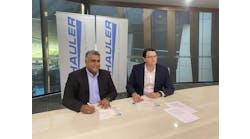The long running saga of the ISA 100.11a wireless standard took a further intriguing turn in Orlando, Florida last month when a number of related sub-committees met alongside the ARC forum. Perhaps the most significant meeting was that considering the results of the "Nice Use Case Analysis Project," so called because it originated at a meeting in Nice, France in 2008 (pleasant places these meetings have to be held in!).
Funded by Shell Global Solutions, the analysis considered just one use case—that of a temperature transmitter sensing sea temperature and displaying it ashore—and only looked at about a third of the complete ISA 100.11a specification. Nevertheless it is understood to have come up with more than a dozen elements of the standard which were either missing, didn't work or conflicted with other elements.
What's so interesting about these findings, apart from the suggestion that the standard, as approved in August of 2009, is incomplete and potentially unworkable, is that they relate back directly to issues raise by the appeal against its ratification made by, among others, Walt Boyes of Control magazine, Sicco Dwars of Shell Global Solutions and Frederick Enns of Dust Networks. That is hardly surprising, perhaps, as no doubt supporters of the standard will be quick to point out, since Dwars was apparently responsible for initiating the Nice use case project and Enns was one of those involved in conducting the analysis and made the presentation on it at the Orlando meeting. Readers will recall that it was rejection of that appeal by ISA on the grounds that it was submitted after the deadline which led to the failure of the America National Standards Institute (ANSI) to accept the standard at its November 2009 meeting. Supporters of that appeal are now arguing that the Nice use case analysis confirms what they had been arguing all along, namely that by failing to follow their own procedures correctly when assessing technical comments on the standard prior to its final ratification, they allowed previously identified deficiencies and inconsistencies to remain in the final document.
Face saving
Ironically, however, these latest developments look as if they may provide ISA with a face saving solution to the dilemma posed by ANSI's insistence that the appeal be heard. While nobody is going to admit that there is anything wrong with the existing version of the standard, the word on the Orlando street is that ISA 100.11a will undergo "maintenance" over the coming months to render it "more robust" and that the resultant revised document will then be put out to ballot in time for it to be released in the early autumn, ideally at the new ISA Automation Week event in Houston in October. The beauty of this solution is that, while it tacitly overcomes the original objections, it obviates the need to hear the appeal since it will be a new, rather than the original, document which will eventually be submitted to ANSI and which should therefore meet with that body's unqualified approval—assuming, of course, that ISA manages to follow its own procedures correctly this time around.
Meanwhile, also meeting at Orlando was ISA 100.12, the sub-committee charged with finding a way to converge ISA 100.11a with WirelessHART. Logically one would expect that any sign of further delay in finalizing the ISA standard, which can only increase WirelessHART's already substantial lead, would encourage efforts to accelerate the convergence project, not least because, as Gary Mintchell of Automation World reported in his "Feed Forward" blog, "… a panel of practitioners at one session at the ARC Forum uniformly pleaded for a single wireless standard."
Mintchell's assessment of the current state of the convergence project is blunt in the extreme. "… attempts to rationalize the differences between the two standards appear to be dead," he says. And he's not alone in pointing out that while the HART Foundation has been repeatedly criticized for being a 'pay-to-play' supplier consortium, dominated as many believe, or at least find it convenient to suggest, by a single supplier, Emerson, the ISA's own wireless activities, which purport to be user driven, are in fact increasingly being identified with Honeywell and the chip supplier Nivis.
If all that's giving you a feeling of déjà vu, it's probably because you're being reminded of such alleged,but largely spurious past red herrings as Rockwell-DeviceNet, Siemens-Profibus and Emerson -- Foundation fieldbus or even, if your memory stretches back far enough, IBM - Token Ring and Xerox/DEC- Ethernet!



